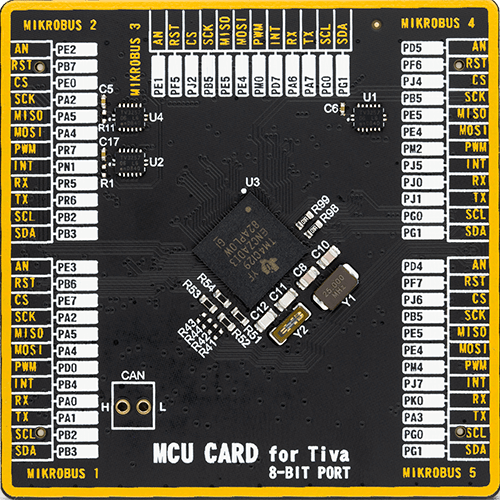在各种环境中通过精确的重量测量来解锁基于数据的决策。
A
A
硬件概览
它是如何工作的?
Load Cell 2 Click是基于Nuvoton的NAU7802,这是一款精密低功耗24位模拟-数字转换器(ADC),具有内置低噪声可编程增益放大器(PGA)、内置RC或晶体振荡器以及精密24位sigma-delta(Σ-Δ)模拟到数字转换器(ADC)。NAU7802设备可实现高达23位的ENOB(有效位数)。该设备为桥接/传感器测量提供了完整的前端解决方案,例如称重秤、应变仪等许多高分辨率、低采样率的应用。NAU7802具有许多内置功能,可在低外部部件计数的情况下
实现高性能应用。此外,工作电流和待机电流低,且包含许多电源管理功能。这些功能使得只有在需要时才供电芯片的那些元件,并且如果不需要完整的23位ENOB性能,则以大大降低的功率运行。可编程增益放大器(PGA)提供了可选择的增益,范围从1到128。A/D转换是通过sigma-delta调制器和可编程FIR滤波器执行的,该滤波器提供了一个同时的50Hz和60Hz陷波滤波器,以提高抗干扰能力。此外,该设备提供了标准的2线接口,与I2C协议兼容,可简单
直接地连接到各种可能的主机处理器并进行互操作。对于低精度应用,不需要校准,但在敏感应用中可能需要。当使用校准时,系统设计人员有三种选项(详见NAU7802数据手册)。这个Click board™只能使用3.3V逻辑电压级别进行操作。在使用具有不同逻辑电平的MCU之前,板子必须执行适当的逻辑电压级别转换。此外,它配备了一个包含函数和示例代码的库,可用作进一步开发的参考。
功能概述
开发板
Fusion for TIVA v8 是一款专为快速开发嵌入式应用的需求而特别设计的开发板。它支持广泛的微控制器,如不同的32位ARM® Cortex®-M基础MCUs,来自Texas Instruments,无论它们的引脚数量如何,并且具有一系列独特功能,例如首次通过WiFi网络实现的嵌入式调试器/程序员。开发板布局合理,设计周到,使得最终用户可以在一个地方找到所有必要的元素,如开关、按钮、指示灯、连接器等。得益于创新的制造技术,Fusion for TIVA v8 提供了流畅而沉浸式的工作体验,允许在任何情况下、任何地方、任何
时候都能访问。Fusion for TIVA v8开发板的每个部分都包含了使同一板块运行最高效的必要组件。一个先进的集成CODEGRIP程序/调试模块提供许多有价值的编程/调试选项,包括对JTAG、SWD和SWO Trace(单线输出)的支持,并与Mikroe软件环境无缝集成。此外,它还包括一个干净且调节过的开发板电源供应模块。它可以使用广泛的外部电源,包括电池、外部12V电源供应和通过USB Type-C(USB-C)连接器的电源。通信选项如USB-UART、USB HOST/DEVICE、CAN(如果MCU卡支持的话)和以
太网也包括在内。此外,它还拥有广受好评的 mikroBUS™标准,为MCU卡提供了标准化插座(SiBRAIN标准),以及两种显示选项,用于TFT板线产品和基于字符的LCD。Fusion for TIVA v8 是Mikroe快速开发生态系统的一个组成部分。它由Mikroe软件工具原生支持,得益于大量不同的Click板™(超过一千块板),其数量每天都在增长,它涵盖了原型制作和开发的许多方面。
微控制器概述
MCU卡片 / MCU

类型
8th Generation
建筑
ARM Cortex-M4
MCU 内存 (KB)
1024
硅供应商
Texas Instruments
引脚数
212
RAM (字节)
262144
使用的MCU引脚
mikroBUS™映射器
“仔细看看!”
Click board™ 原理图

一步一步来
项目组装
实时跟踪您的结果
应用程序输出
1. 应用程序输出 - 在调试模式下,“应用程序输出”窗口支持实时数据监控,直接提供执行结果的可视化。请按照提供的教程正确配置环境,以确保数据正确显示。

2. UART 终端 - 使用UART Terminal通过USB to UART converter监视数据传输,实现Click board™与开发系统之间的直接通信。请根据项目需求配置波特率和其他串行设置,以确保正常运行。有关分步设置说明,请参考提供的教程。

3. Plot 输出 - Plot功能提供了一种强大的方式来可视化实时传感器数据,使趋势分析、调试和多个数据点的对比变得更加直观。要正确设置,请按照提供的教程,其中包含使用Plot功能显示Click board™读数的分步示例。在代码中使用Plot功能时,请使用以下函数:plot(insert_graph_name, variable_name);。这是一个通用格式,用户需要将“insert_graph_name”替换为实际图表名称,并将“variable_name”替换为要显示的参数。

软件支持
库描述
该库包含 Load Cell 2 Click 驱动程序的 API。
关键功能:
loadcell2_get_weight- 获取重量的函数loadcell2_get_result- 获取结果的函数loadcell2_calibration- 校准函数
开源
代码示例
完整的应用程序代码和一个现成的项目可以通过NECTO Studio包管理器直接安装到NECTO Studio。 应用程序代码也可以在MIKROE的GitHub账户中找到。
/*!
* \file
* \brief LoadCell2 Click example
*
* # Description
* Load Cell 2 Click is a weight measurement Click
* which utilizes a load cell element,
* in order to precisely measure the weight of an object.
*
* The demo application is composed of two sections :
*
* ## Application Init
* Initializes I2C driver and performs the device reset,
* and performs the device reset, set power on and default configuration.
* Sets tare the scale, calibrate scale and start measurements.
*
* ## Application Task
* This is an example which demonstrates the
* use of Load Cell 2 Click board.
* Display the measurement of scales in grams [g].
* Results are being sent to the Usart Terminal
* where you can track their changes.
* All data logs write on USB uart changes for every 1 sec.
*
* \author Nenad Filipovic
*
*/
// ------------------------------------------------------------------- INCLUDES
#include "board.h"
#include "log.h"
#include "loadcell2.h"
// ------------------------------------------------------------------ VARIABLES
static loadcell2_t loadcell2;
static log_t logger;
static loadcell2_data_t cell_data;
static float weight_val;
// ------------------------------------------------------ APPLICATION FUNCTIONS
void application_init ( void )
{
log_cfg_t log_cfg;
loadcell2_cfg_t cfg;
/**
* Logger initialization.
* Default baud rate: 115200
* Default log level: LOG_LEVEL_DEBUG
* @note If USB_UART_RX and USB_UART_TX
* are defined as HAL_PIN_NC, you will
* need to define them manually for log to work.
* See @b LOG_MAP_USB_UART macro definition for detailed explanation.
*/
LOG_MAP_USB_UART( log_cfg );
log_init( &logger, &log_cfg );
log_info( &logger, "---- Application Init ----" );
// Click initialization.
loadcell2_cfg_setup( &cfg );
LOADCELL2_MAP_MIKROBUS( cfg, MIKROBUS_1 );
loadcell2_init( &loadcell2, &cfg );
log_printf( &logger, "-------------------------\r\n");
log_printf( &logger, " Load cell Click \r\n");
log_printf( &logger, "-------------------------\r\n");
Delay_ms ( 100 );
log_printf( &logger, "-------------------------\r\n");
log_printf( &logger, " Reset all registers \r\n");
loadcell2_reset( &loadcell2 );
Delay_ms ( 100 );
log_printf( &logger, "-------------------------\r\n");
log_printf( &logger, " Power On \r\n");
loadcell2_power_on( &loadcell2 );
Delay_ms ( 100 );
log_printf( &logger, "-------------------------\r\n");
log_printf( &logger, " Set default config. \r\n");
loadcell2_default_cfg( &loadcell2 );
Delay_ms ( 100 );
log_printf( &logger, "-------------------------\r\n");
log_printf( &logger, " Calibrate AFE \r\n");
loadcell2_calibrate_afe( &loadcell2 );
Delay_ms ( 1000 );
log_printf( &logger, "-------------------------\r\n");
log_printf( &logger, " Tare the scale : \r\n");
log_printf( &logger, "- - - - - - - - - - - - -\r\n");
log_printf( &logger, " >> Remove all object << \r\n");
log_printf( &logger, "- - - - - - - - - - - - -\r\n");
log_printf( &logger, " In the following 10 sec \r\n");
log_printf( &logger, " please remove all object\r\n");
log_printf( &logger, " from the scale. \r\n");
// 10 seconds delay
Delay_ms ( 1000 );
Delay_ms ( 1000 );
Delay_ms ( 1000 );
Delay_ms ( 1000 );
Delay_ms ( 1000 );
Delay_ms ( 1000 );
Delay_ms ( 1000 );
Delay_ms ( 1000 );
Delay_ms ( 1000 );
Delay_ms ( 1000 );
log_printf( &logger, "-------------------------\r\n");
log_printf( &logger, " Start tare scales \r\n");
loadcell2_tare ( &loadcell2, &cell_data );
Delay_ms ( 500 );
log_printf( &logger, "-------------------------\r\n");
log_printf( &logger, " Tarring is complete \r\n");
log_printf( &logger, "-------------------------\r\n");
log_printf( &logger, " Calibrate Scale : \r\n");
log_printf( &logger, "- - - - - - - - - - - - -\r\n");
log_printf( &logger, " >>> Load etalon <<< \r\n");
log_printf( &logger, "- - - - - - - - - - - - -\r\n");
log_printf( &logger, " In the following 10 sec \r\n");
log_printf( &logger, "place 1000g weight etalon\r\n");
log_printf( &logger, " on the scale for \r\n");
log_printf( &logger, " calibration purpose. \r\n");
// 10 seconds delay
Delay_ms ( 1000 );
Delay_ms ( 1000 );
Delay_ms ( 1000 );
Delay_ms ( 1000 );
Delay_ms ( 1000 );
Delay_ms ( 1000 );
Delay_ms ( 1000 );
Delay_ms ( 1000 );
Delay_ms ( 1000 );
Delay_ms ( 1000 );
log_printf( &logger, "-------------------------\r\n");
log_printf( &logger, " Start calibration \r\n");
if ( loadcell2_calibration ( &loadcell2, LOADCELL2_WEIGHT_1000G, &cell_data ) == LOADCELL2_GET_RESULT_OK )
{
log_printf( &logger, "-------------------------\r\n");
log_printf( &logger, " Calibration Done \r\n");
log_printf( &logger, "- - - - - - - - - - - - -\r\n");
log_printf( &logger, " >>> Remove etalon <<< \r\n");
log_printf( &logger, "- - - - - - - - - - - - -\r\n");
log_printf( &logger, " In the following 10 sec \r\n");
log_printf( &logger, " remove 1000g weight \r\n");
log_printf( &logger, " etalon on the scale. \r\n");
// 10 seconds delay
Delay_ms ( 1000 );
Delay_ms ( 1000 );
Delay_ms ( 1000 );
Delay_ms ( 1000 );
Delay_ms ( 1000 );
Delay_ms ( 1000 );
Delay_ms ( 1000 );
Delay_ms ( 1000 );
Delay_ms ( 1000 );
Delay_ms ( 1000 );
}
else
{
log_printf( &logger, "-------------------------\r\n");
log_printf( &logger, " Calibration Error \r\n");
for ( ; ; );
}
log_printf( &logger, "-------------------------\r\n");
log_printf( &logger, " Start measurements : \r\n");
log_printf( &logger, "-------------------------\r\n");
}
void application_task ( void )
{
weight_val = loadcell2_get_weight( &loadcell2, &cell_data );
log_printf(&logger, " Weight : %.2f g\r\n", weight_val );
Delay_ms ( 1000 );
}
int main ( void )
{
/* Do not remove this line or clock might not be set correctly. */
#ifdef PREINIT_SUPPORTED
preinit();
#endif
application_init( );
for ( ; ; )
{
application_task( );
}
return 0;
}
// ------------------------------------------------------------------------ END


































